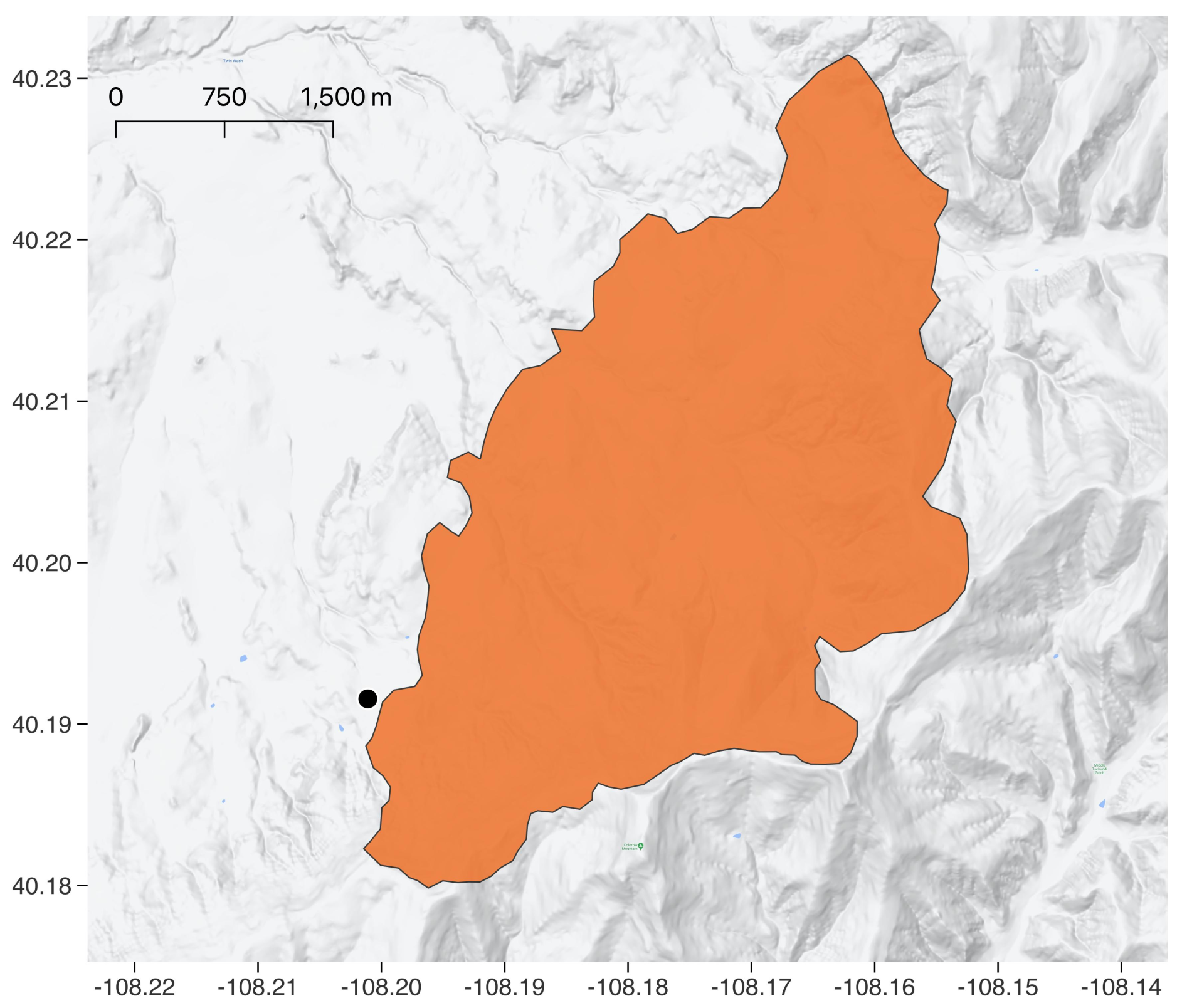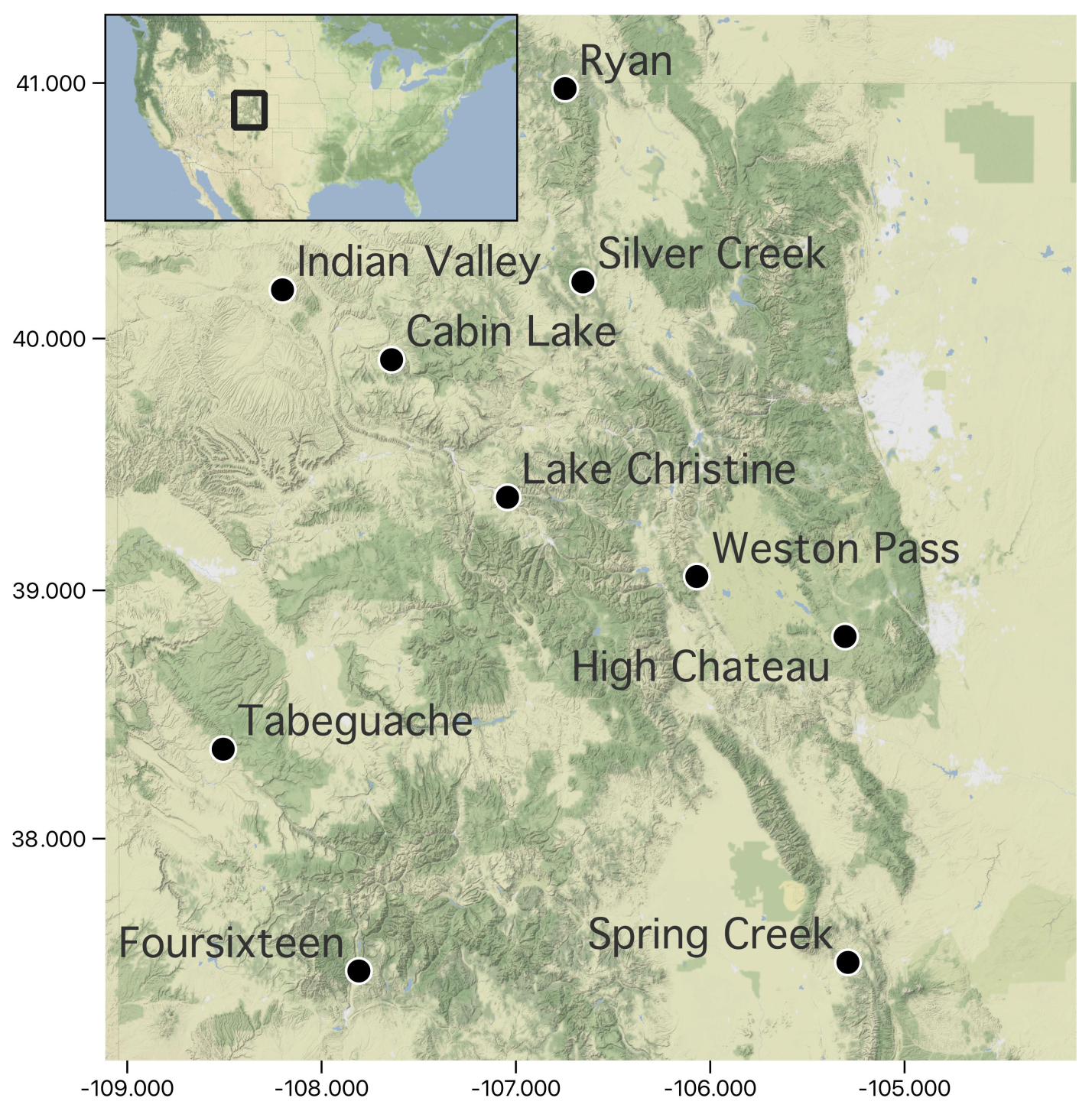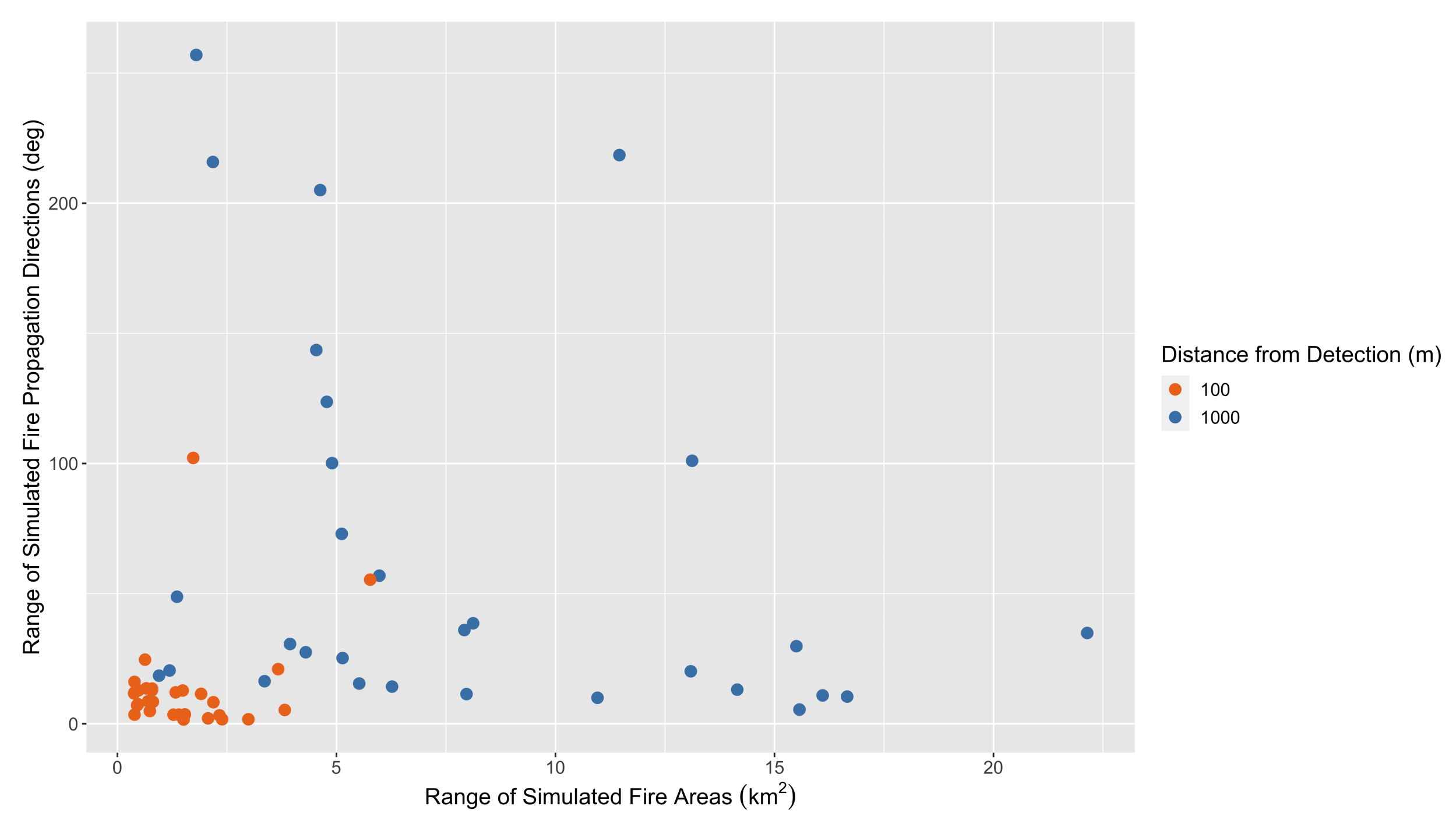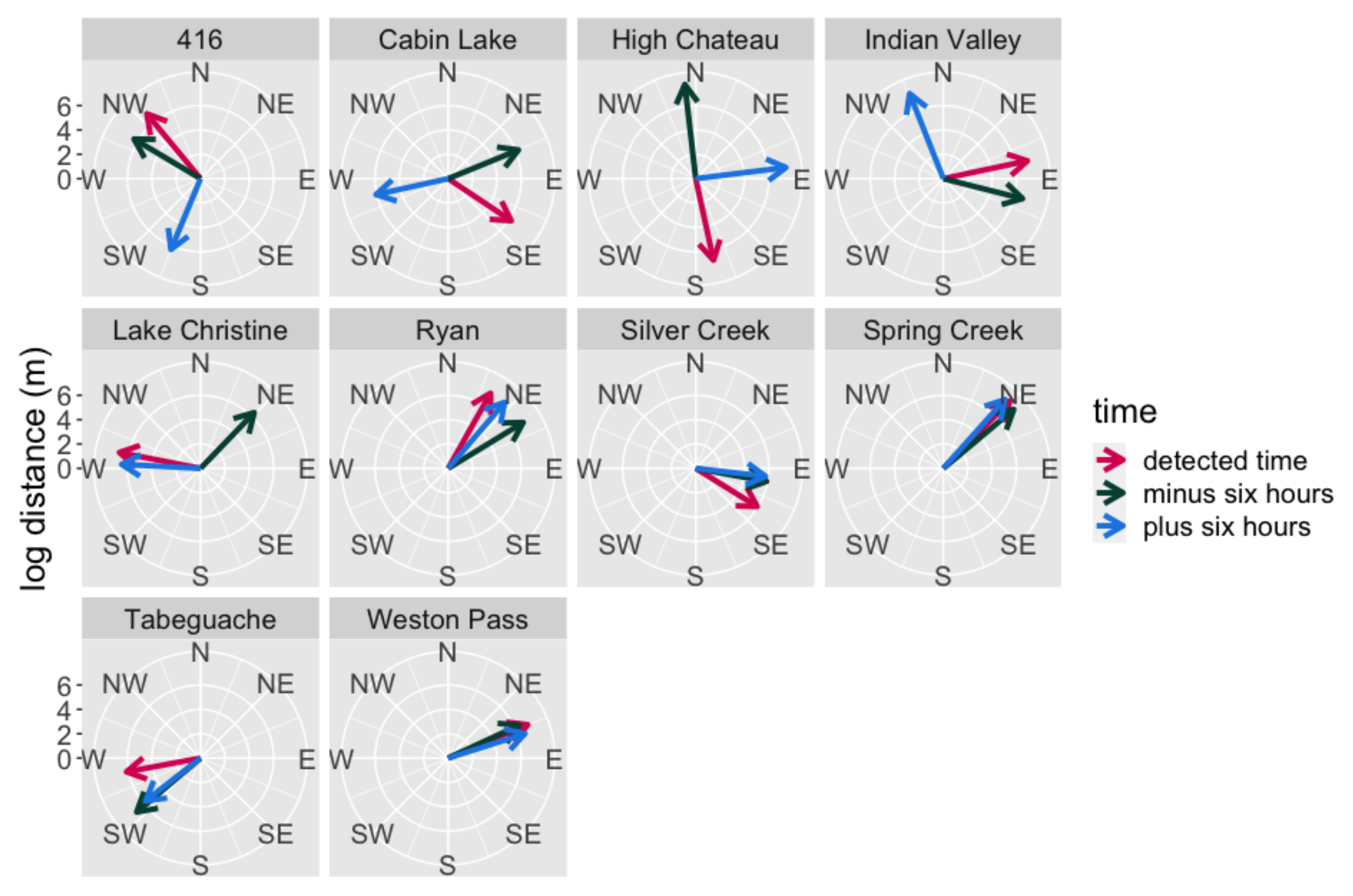Weather Research and Forecasting—Fire Simulated Burned Area and Propagation Direction Sensitivity to Initiation Point Location and Time
Abstract
:1. Introduction
2. Materials and Methods
2.1. WRF-Fire
2.2. Incident Report Analysis
2.3. Case Study Selection
3. Results
3.1. Effects of Initiation Point Location on Forecast Burn Area
3.2. Effects of Initiation Time on Forecast Area
3.3. Effects of Initiation Point Location on Forecast Propagation Direction
3.4. Effects of Initiation Time on Forecast Propagation Direction
3.5. Effects of Both Initiation Point Location and Initiation Time on Forecast Area and Propagation Direction
4. Discussion
5. Conclusions
Author Contributions
Funding
Institutional Review Board Statement
Informed Consent Statement
Data Availability Statement
Acknowledgments
Conflicts of Interest
References
- Breedt, J.A.; Dreber, N.; Kellner, K. Post-wildfire regeneration of rangeland productivity and functionality–observations across three semi-arid vegetation types in South Africa. Afr. J. Range Forage Sci. 2013, 30, 161–167. [Google Scholar] [CrossRef]
- Lisa, C.; Paffetti, D.; Nocentini, S.; Marchi, E.; Bottalico, F.; Fiorentini, S.; Travaglini, D. Impact of wildfire on the edaphic microarthropod community in a Pinus pinaster forest in central Italy. iForest-Biogeosciences For. 2015, 8, 874. [Google Scholar] [CrossRef] [Green Version]
- Korb, J.E.; Fornwalt, P.J.; Stevens-Rumann, C.S. What drives ponderosa pine regeneration following wildfire in the western United States? For. Ecol. Manag. 2019, 454, 117663. [Google Scholar] [CrossRef]
- Lagouvardos, K.; Kotroni, V.; Giannaros, T.M.; Dafis, S. Meteorological conditions conducive to the rapid spread of the deadly wildfire in eastern Attica, Greece. Bull. Am. Meteorol. Soc. 2019, 100, 2137–2145. [Google Scholar] [CrossRef]
- Brewer, J.M.; Clements, B.C. The 2018 Camp Fire: Meteorological analysis using in situ observations and numerical simulations. Atmosphere 2019, 11, 47. [Google Scholar] [CrossRef] [Green Version]
- Abatzoglou, J.T.; Kolden, C.A. Climate change in western US deserts: Potential for increased wildfire and invasive annual grasses. Rangel. Ecol. Manag. 2011, 64, 471–478. [Google Scholar] [CrossRef]
- Brando, P.M.; Paolucci, L.; Ummenhofer, C.C.; Ordway, E.M.; Hartmann, H.; Cattau, M.E.; Rattis, L.; Medjibe, V.; Coe, M.T.; Balch, J. Droughts, wildfires, and forest carbon cycling: A pantropical synthesis. Annu. Rev. Earth Planet. Sci. 2019, 47, 555–581. [Google Scholar] [CrossRef]
- Balch, J.K.; Bradley, B.A.; Abatzoglou, J.T.; Nagy, R.C.; Fusco, E.J.; Mahood, A.L. Human-started wildfires expand the fire niche across the United States. Proc. Natl. Acad. Sci. USA 2017, 114, 2946–2951. [Google Scholar] [CrossRef] [Green Version]
- Bowman, D.M.; Williamson, G.J.; Abatzoglou, J.T.; Kolden, C.A.; Cochrane, M.A.; Smith, A. Human exposure and sensitivity to globally extreme wildfire events. Nat. Ecol. Evol. 2017, 1, 1–6. [Google Scholar] [CrossRef]
- Bowman, D.M.; Kolden, C.A.; Abatzoglou, J.T.; Johnston, F.H.; van der Werf, G.R.; Flannigan, M. Vegetation fires in the Anthropocene. Nat. Rev. Earth Environ. 2020, 1, 500–515. [Google Scholar] [CrossRef]
- Strom, B.A.; Fulé, P.Z. Pre-wildfire fuel treatments affect long-term ponderosa pine forest dynamics. Int. J. Wildland Fire 2007, 16, 128–138. [Google Scholar] [CrossRef]
- Miesel, J.; Reiner, A.; Ewell, C.; Maestrini, B.; Dickinson, M. Quantifying changes in total and pyrogenic carbon stocks across fire severity gradients using active wildfire incidents. Front. Earth Sci. 2018, 6, 41. [Google Scholar] [CrossRef] [Green Version]
- Dey, D.C.; Knapp, B.O.; Battaglia, M.A.; Deal, R.L.; Hart, J.L.; O’Hara, K.L.; Schuler, T.M. Barriers to natural regeneration in temperate forests across the USA. New For. 2019, 50, 11–40. [Google Scholar] [CrossRef]
- McWethy, D.B.; Pauchard, A.; García, R.A.; Holz, A.; González, M.E.; Veblen, T.T.; Currey, B. Landscape drivers of recent fire activity (2001–2017) in south-central Chile. PLoS ONE 2018, 13, e0201195. [Google Scholar] [CrossRef]
- O’Connor, C.D.; Thompson, M.P.; Rodríguez, S.F. Getting ahead of the wildfire problem: Quantifying and mapping management challenges and opportunities. Geosciences 2016, 6, 35. [Google Scholar] [CrossRef] [Green Version]
- Cruz, M.G.; Alexander, M.E. Uncertainty associated with model predictions of surface and crown fire rates of spread. Environ. Model. Softw. 2013, 47, 16–28. [Google Scholar] [CrossRef]
- Cruz, M.G.; Alexander, M.E.; Sullivan, A.L.; Gould, J.S.; Kilinc, M. Assessing improvements in models used to operationally predict wildland fire rate of spread. Environ. Model. Softw. 2018, 105, 54–63. [Google Scholar] [CrossRef]
- Benali, A.; Sá, A.C.; Ervilha, A.R.; Trigo, R.M.; Fernandes, P.M.; Pereira, J.M. Fire spread predictions: Sweeping uncertainty under the rug. Sci. Total Environ. 2017, 592, 187–196. [Google Scholar] [CrossRef] [Green Version]
- Alkhatib, A.A. A review on forest fire detection techniques. Int. J. Distrib. Sens. Netw. 2014, 10, 597368. [Google Scholar] [CrossRef] [Green Version]
- Integrated Reporting of Wildland-Fire Information. Available online: https://nifc.maps.arcgis.com/apps (accessed on 10 March 2022).
- Hoffman, C.M.; Sieg, C.H.; Linn, R.R.; Mell, W.; Parsons, R.A.; Ziegler, J.P.; Hiers, J.K. Advancing the science of wildland fire dynamics using process-based models. Fire 2018, 1, 32. [Google Scholar] [CrossRef] [Green Version]
- Mutlu, M.; Popescu, S.C.; Zhao, K. Sensitivity analysis of fire behavior modeling with LIDAR-derived surface fuel maps. For. Ecol. Manag. 2008, 256, 289–294. [Google Scholar] [CrossRef]
- Asensio-Sevilla, M.I.; Santos-Martín, M.T.; Álvarez-León, D.; Ferragut-Canals, L. Global sensitivity analysis of fuel-type-dependent input variables of a simplified physical fire spread model. Math. Comput. Simul. 2020, 172, 33–44. [Google Scholar] [CrossRef]
- Clark, R.E.; Hope, A.S.; Tarantola, S.; Gatelli, D.; Dennison, P.E.; Moritz, M.A. Sensitivity analysis of a fire spread model in a chaparral landscape. Fire Ecol. 2008, 4, 1–13. [Google Scholar] [CrossRef]
- Anderson, K.; Reuter, G.; Flannigan, M.D. Fire-growth modelling using meteorological data with random and systematic perturbations. Int. J. Wildland Fire 2007, 16, 174–182. [Google Scholar] [CrossRef]
- Bachmann, A.; Allgöwer, B. Uncertainty propagation in wildland fire behaviour modelling. Int. J. Geogr. Inf. Sci. 2002, 16, 115–127. [Google Scholar] [CrossRef]
- Rapp, C.; Rabung, E.; Wilson, R.; Toman, E. Wildfire decision support tools: An exploratory study of use in the United States. Int. J. Wildland Fire 2020, 29, 581–594. [Google Scholar] [CrossRef]
- Mandel, J.; Beezley, J.D.; Bennethum, L.S.; Chakraborty, S.; Coen, J.L.; Douglas, C.C.; Vodacek, A. A Dynamic Data Driven Wildland Fire Model; Springer: Berlin/Heidelberg, Germany, 2007; pp. 1042–1049. [Google Scholar]
- Mandel, J.; Beezley, J.D.; Kochanski, A.K. Coupled atmosphere-wildland fire modeling with WRF 3.3 and SFIRE 2011. Geosci. Model Dev. 2011, 4, 591–610. [Google Scholar] [CrossRef] [Green Version]
- Skamarock, W.C.; Klemp, J.B.; Dudhia, J.; Gill, D.O.; Barker, D.M.; Wang, W.; Powers, J.G. A Description of the Advanced Research WRF Version 2; National Center for Atmospheric Research Boulder Co Mesoscale and Microscale Meteorology Div.: Boulder, CO, USA, 2005; Available online: https://www.researchgate.net/publication/244955031_A_Description_of_the_Advanced_Research_WRF_Version_2 (accessed on 10 March 2022).
- Coen, J.L.; Cameron, M.; Michalakes, J.; Patton, E.G.; Riggan, P.J.; Yedinak, K.M. WRF-Fire: Coupled weather–wildland fire modeling with the weather research and forecasting model. J. Appl. Meteorol. Climatol. 2013, 52, 16–38. [Google Scholar] [CrossRef]
- Rothermel, R.C. A Mathematical Model for Predicting Fire Spread in Wildland Fuels; Intermountain Forest Range Experiment Station, Forest Service, US Department of Agriculture: Ogden, UT, USA, 1972; Volume 115, pp. 5–32.
- Mandel, J. Fourier Estimates for a Multigrid. In Multigrid Methods: Theory, Applications, and Supercomputing; CRC Press: Boca Raton, FL, USA, 2020; p. 389. Available online: https://apps.dtic.mil/sti/pdfs/ADA204385.pdf#page=395 (accessed on 10 March 2022).
- Moeng, C.H.; Dudhia, J.; Klemp, J.; Sullivan, P. Examining two-way grid nesting for large eddy simulation of the PBL using the WRF model. Mon. Weather. Rev. 2007, 135, 2295–2311. [Google Scholar] [CrossRef]
- Jiménez, P.A.; Muñoz-Esparza, D.; Kosović, B. A high resolution coupled fire–atmosphere forecasting system to minimize the impacts of wildland fires: Applications to the Chimney Tops II wildland event. Atmosphere 2018, 9, 197. [Google Scholar] [CrossRef] [Green Version]
- Benjamin, S.G.; Weygandt, S.S.; Brown, J.M.; Hu, M.; Alexander, C.R.; Smirnova, T.G.; Manikin, G.S. A North American hourly assimilation and model forecast cycle: The Rapid Refresh. Mon. Weather. Rev. 2016, 144, 1669–1694. [Google Scholar] [CrossRef]
- Ryan, K.C.; Opperman, T.S. LANDFIRE–A national vegetation/fuels data base for use in fuels treatment, restoration, and suppression planning. For. Ecol. Manag. 2008, 294, 208–216. [Google Scholar] [CrossRef] [Green Version]
- Rollins, M.G. LANDFIRE: A nationally consistent vegetation, wildland fire, and fuel assessment. Int. J. Wildland Fire 2009, 18, 235–249. [Google Scholar] [CrossRef] [Green Version]
- Scott, J.H.; Burgan, R.E. Standard Fire Behavior Fuel Models: A Comprehensive Set for Use with Rothermel’s Surface Fire Spread Model (General Technical Report RMRS-GTR-153); US Department of Agriculture, US Forest Service, Rocky Mountain Research Station: Fort Collins, CO, USA, 2005.
- National Interagency Fire Center. Available online: https:https://www.nifc.gov (accessed on 10 March 2022).










| Fire Name | Detection Date | Detection Time |
|---|---|---|
| 416 | 1 June 2018 | 1602 |
| Cabin Lake | 29 July 2018 | 2000 |
| High Chateau | 29 July 2018 | 2000 |
| Indian Valley | 20 July 2018 | 2030 |
| Lake Christine | 3 July 2018 | 0011 |
| Ryan | 16 September 2018 | 0136 |
| Silver Creek | 19 July 2018 | 2030 |
| Spring Creek | 27 June 2018 | 2130 |
| Tabeguache | 7 July 2018 | 0434 |
| Weston Pass | 28 June 2018 | 2030 |
| Dependent Variable | |
|---|---|
| Area_range | |
| n_fuel | −0.351 *** |
| (0.079) | |
| slope_range | 0.001 |
| (0.009) | |
| aspect_range | 0.005 *** |
| (0.001) | |
| wdir_range | 0.010 *** |
| (0.004) | |
| wspd_range | 0.119 * |
| (0.065) | |
| Constant | 1.530 *** |
| (0.267) |
| Dependent Variable | |
|---|---|
| Dir_range | |
| n_fuel | 0.112 *** |
| (0.027) | |
| slope_range | 0.057 *** |
| (0.003) | |
| aspect_range | 0.002 *** |
| (0.0003) | |
| wdir_range | 0.017 *** |
| (0.001) | |
| wspd_range | 0.085 *** |
| (0.023) | |
| Constant | 1.395 *** |
| (0.126) |
Publisher’s Note: MDPI stays neutral with regard to jurisdictional claims in published maps and institutional affiliations. |
© 2022 by the authors. Licensee MDPI, Basel, Switzerland. This article is an open access article distributed under the terms and conditions of the Creative Commons Attribution (CC BY) license (https://creativecommons.org/licenses/by/4.0/).
Share and Cite
DeCastro, A.; Siems-Anderson, A.; Smith, E.; Knievel, J.C.; Kosović, B.; Brown, B.G.; Balch, J.K. Weather Research and Forecasting—Fire Simulated Burned Area and Propagation Direction Sensitivity to Initiation Point Location and Time. Fire 2022, 5, 58. https://doi.org/10.3390/fire5030058
DeCastro A, Siems-Anderson A, Smith E, Knievel JC, Kosović B, Brown BG, Balch JK. Weather Research and Forecasting—Fire Simulated Burned Area and Propagation Direction Sensitivity to Initiation Point Location and Time. Fire. 2022; 5(3):58. https://doi.org/10.3390/fire5030058
Chicago/Turabian StyleDeCastro, Amy, Amanda Siems-Anderson, Ebone Smith, Jason C. Knievel, Branko Kosović, Barbara G. Brown, and Jennifer K. Balch. 2022. "Weather Research and Forecasting—Fire Simulated Burned Area and Propagation Direction Sensitivity to Initiation Point Location and Time" Fire 5, no. 3: 58. https://doi.org/10.3390/fire5030058
APA StyleDeCastro, A., Siems-Anderson, A., Smith, E., Knievel, J. C., Kosović, B., Brown, B. G., & Balch, J. K. (2022). Weather Research and Forecasting—Fire Simulated Burned Area and Propagation Direction Sensitivity to Initiation Point Location and Time. Fire, 5(3), 58. https://doi.org/10.3390/fire5030058






